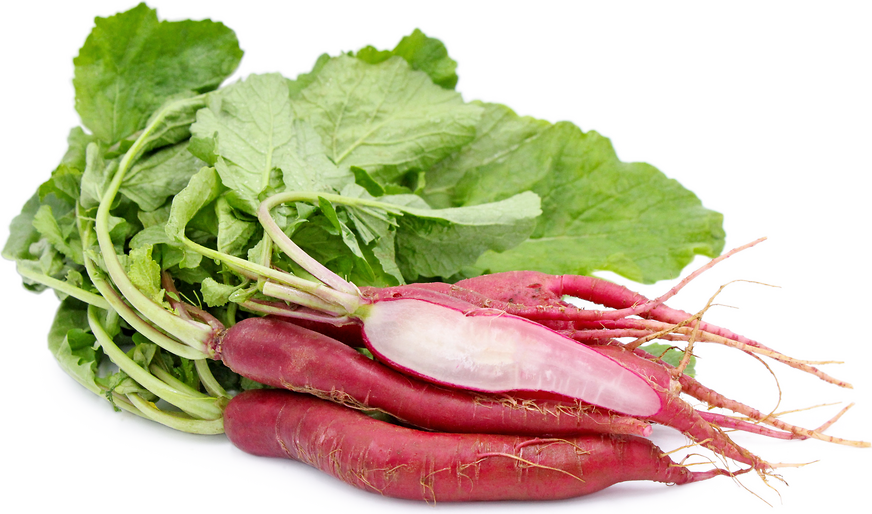


Long Scarlet Radish
Estimated Inventory, bunch : 0
Description/Taste
Long Scarlet radishes are elongated, thin roots, averaging 15 to 17 centimeters in length, and have a straight, tapered shape, similar in appearance to a carrot with curved shoulders and a distinct point. The roots have thin and vibrant red-pink skin with a semi-smooth and firm consistency, sometimes covered in fine root hairs. Underneath the surface, the flesh is dense, semi-aqueous, and white, known for its tender and crisp, snap-like quality. Long Scarlet radishes have a milder flavor than common radish varieties and offer a subtly sweet, earthy, and peppery bite. In addition to the roots, the radishes develop compact, short leafy green tops. The leaves have a crisp, faintly rough texture, comprised of prominent veining, and contribute an herbaceous, vegetal, grassy, and pungent taste.
Seasons/Availability
Long Scarlet radishes are available year-round, with a peak season in the spring through fall.
Current Facts
Long Scarlet radishes, botanically classified as Raphanus sativus, are an American heirloom variety belonging to the Brassicaceae family. The 19th-century cultivar was once one of the most popular long radish varieties cultivated in the United States and was highly favored for its easy-to-grow nature. Long Scarlet radishes are also known as Cincinnati Market radishes, Extra Long Scarlet Short Top radishes, Long Scarlet Cincinnati radishes, Cincinnati Glass radishes, and Cincinnati Glass carrots. The scarlet red cultivar obtained its “glass” moniker from being grown in glass greenhouses and garden sheds throughout the Cincinnati area in the 19th century. Long Scarlet radishes were also highly favored for their light, crisp consistency, leading consumers to comment that the radish’s flesh was as delicate as glass. Despite Long Scarlet radishes being one of the most popular varieties in the 19th century, they were eventually replaced with round, red radish cultivars and faded from commercial cultivation. In the modern-day, Long Scarlet radishes are rare, primarily grown as a boutique radish in home gardens and through select growers.
Nutritional Value
Long Scarlet radishes are a source of fiber to stimulate the digestive tract, vitamin B6 to regulate amino acid levels in the bloodstream, and vitamin C to strengthen the immune system. The radishes also provide potassium to balance fluid levels in the body, magnesium to control healthy nerve functions, folate to process carbohydrates into energy, calcium to protect bones and teeth and contain lower amounts of copper, riboflavin, and manganese.
Applications
Long Scarlet radishes have a mild, peppery flavor well-suited for raw and cooked preparations, including roasting, sautéing, grilling, and braising. The radishes can be used fresh on vegetable platters, served with herbs-infused dips, or they can be sliced and tossed into green salads and grain bowls. Long Scarlet radishes are also chopped into salsa or vinaigrettes and spooned over roasted meats, used as a topping over lettuce wraps and tacos, or thinly sliced and layered over toast. Beyond fresh applications, Long Scarlet radishes can be incorporated into brothy soups and noodle bowls, stir-fried with other vegetables, braised as a side dish with radish or mustard greens, lightly cooked and sprinkled over omelets, baked into gratins, or grilled for a smoky flavor. The radishes can also be quick-pickled and placed over sushi or sliced and combined into egg rolls. In addition to the roots, the edible radish tops can be blended into sauces such as pesto, finely chopped and floated over soups, or torn and tossed into salads. Long Scarlet radishes pair well with herbs such as dill, cilantro, mint, and tarragon, green olives, arugula, avocado, snap peas, fennel, potatoes, cheeses including ricotta, goat, feta, and parmesan, honey, and meats such as duck, poultry, steak, and fish. Whole, unwashed Long Scarlet radishes will keep for 1 to 2 weeks when wrapped in a damp paper towel and stored in a plastic bag in the refrigerator. Once cooked, the radishes will keep in a sealed container for 2 to 4 days.
Ethnic/Cultural Info
In the United States, Long Scarlet radishes are favored in the present day as a specialty home garden cultivar. The radishes have characteristically short tops, allowing the plant to send most of its nutrients to grow the long roots. The radishes are also fast-growing, maturing in 30 to 35 days, and the cultivar produces high yields of tender roots with a mild, sweet, and peppery flavor. Long Scarlet radishes are often listed on seed saving websites as a beloved American heirloom variety, and the roots can be grown close together in home gardens, making them suitable for small and compact spaces. The radishes are also valued for their straight, carrot-like shape, and seed savers promote the variety by showcasing its unique shape in photos through social media platforms to encourage the preservation of the heirloom radish.
Geography/History
Long Scarlet radishes are descendants of radishes first cultivated in China and were eventually introduced to Europe and North America. Radishes were extensively grown over time to create varieties with improved growth characteristics, and many cultivars were planted with immigrants as they settled into the United States. Long Scarlet radishes became a favored American home garden variety during the mid to late 19th century and were selectively bred in the region surrounding Cincinnati, Ohio. The radishes were often the most expensive in local markets and were first featured in Parkhurst Cincinnati Seed Warehouse’s catalog in 1835. Multiple Cincinnati seed catalogs also mentioned Long Scarlet radishes as the preferred radish variety in the late 19th century and were believed to have been widely grown through commercial growers and home gardeners throughout the city. Today Long Scarlet radishes have largely fallen out of favor due to modern globe varieties and are considered a rare radish found through select online seed catalogs and local markets in the United States, Canada, Australia, Europe, and Asia.
Recipe Ideas
Recipes that include Long Scarlet Radish. One
| I Breathe I'm Hungry |
|
Pan Roasted Radishes |




